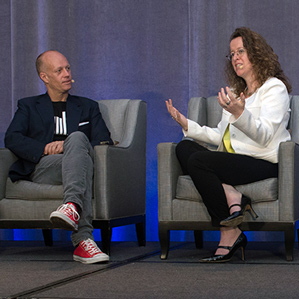Digital Summit: Internet of Things? Think of It as the Internet of Stuff.
The Internet of things—a phrase referring to the ever-growing number of devices connected to the Internet—may be better titled the “Internet of stuff,” says Genevieve Bell, an anthropologist and the director of user experience for Intel.

Speaking at MIT Technology Review’s Digital Summit in San Francisco on Monday, Bell said the word “things” suggests many of the same item. The word “stuff,” on the other hand, is understood to refer to a collection of different things—such as a toothbrush and a traffic light.
“Imagining what it means to connect everything from these to sewer lines is to suggest some very different practical realities and different intents,” she said.
For instance, she said, cities around the world are very different from each other and contain people with diverse cultures and needs. That means there are many distinct reasons why you’d want to connect a city’s infrastructure to the Internet—in one city it might make sense to have sensors monitoring parks, while in another that may seem too intrusive but it’s a good idea to monitor sharks off the coast.
Bell said that when working with her team at Intel, she tries to keep in mind a few things about the world that haven’t changed in a long time: we all want to be part of a family and part of a community; we use objects to talk about who we are; and we all like to tell lies and keep secrets.
She also tries to keep in mind things that are constantly in flux, such as our ideas about privacy and trust. With the growth of the Internet of things, some observers have feared that a larger number of connected devices will lead to more potential privacy intrusions.
Asked if she thinks the general anxiety level about technology is particularly high now, Bell pointed to other moments in history when people had concerns about new technology—such as the early 1900s, when electricity was spreading. Right now, she said, we’re at a point where people are trying to figure out how much technology is too much. For example, they may decide not to bring tablets into the bedroom. Bell said that in her view, this is not so much about rejecting technology as it is about “reasserting our humanity.”
Keep Reading
Most Popular
Large language models can do jaw-dropping things. But nobody knows exactly why.
And that's a problem. Figuring it out is one of the biggest scientific puzzles of our time and a crucial step towards controlling more powerful future models.
How scientists traced a mysterious covid case back to six toilets
When wastewater surveillance turns into a hunt for a single infected individual, the ethics get tricky.
The problem with plug-in hybrids? Their drivers.
Plug-in hybrids are often sold as a transition to EVs, but new data from Europe shows we’re still underestimating the emissions they produce.
Stay connected
Get the latest updates from
MIT Technology Review
Discover special offers, top stories, upcoming events, and more.